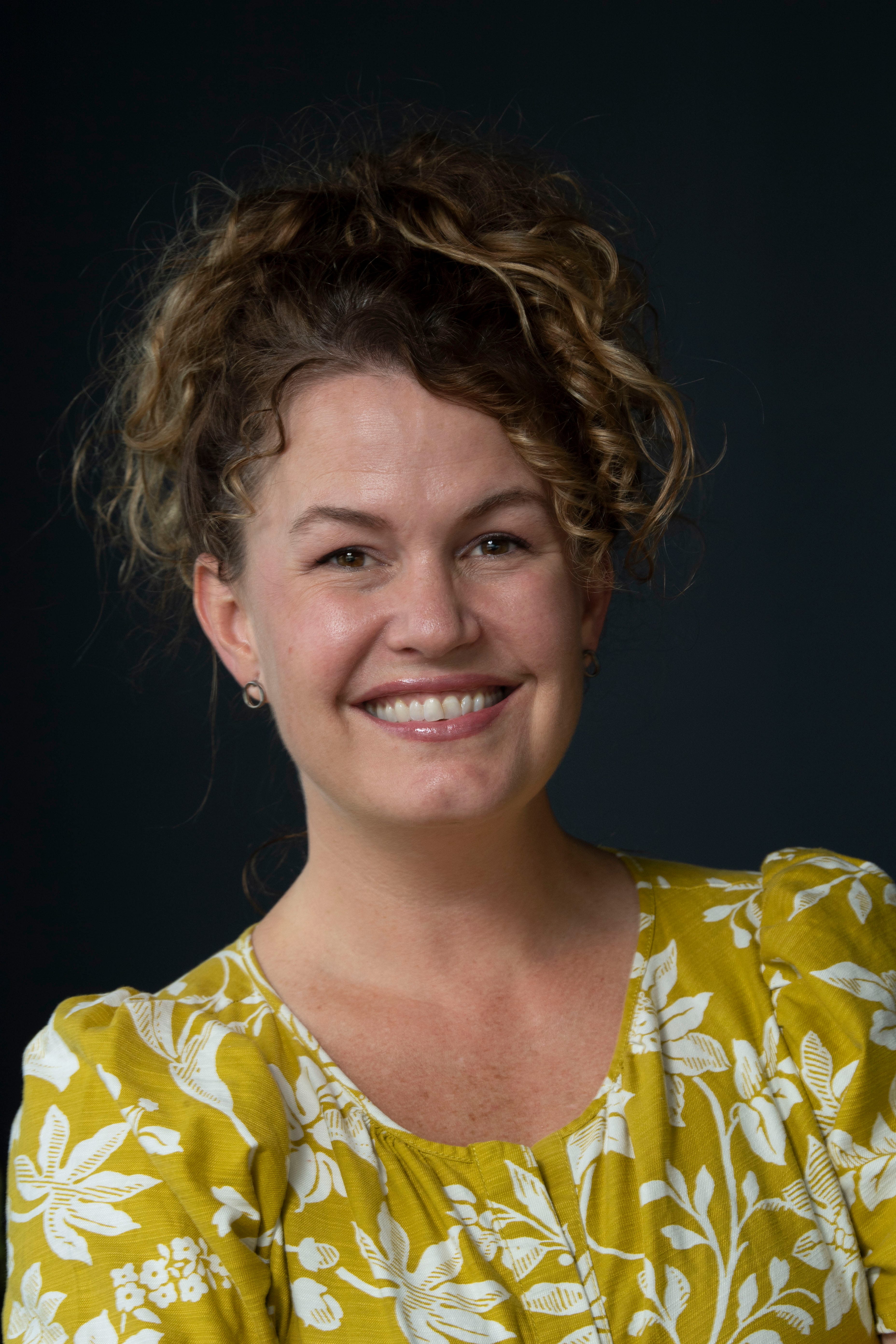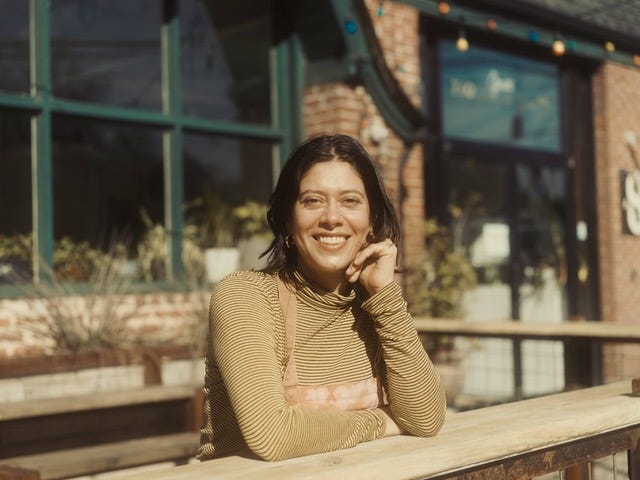Handmade tortillas and hominy grits: Meet 3 Georgia chefs rethinking corn
 Mackensy Lunsford
Mackensy Lunsford
In southern Guanajuato, Mexico, Maricela Vega reconnected with her roots.
In June, the Atlanta-based chef visited her family's village in Cútaro, situated in the foothills of a volcanic basin that spills into Lake Cuitzeo. As a young child, Vega's Tio Fillo would lead the family's goats for hours from his village to drink from that freshwater lake.
This is the land of the Purepecha, Indigenous people of Michoacan who have nurtured landrace, or heirloom, maize varieties for millennia. Vega's own family grew landrace corn and a variety of other crops in the volcanic soil until the mid-'90s.
"I look at it as a direct result of NAFTA," Vega said, referring to the free trade deal Mexico signed with the United States and Canada. As cheap commodity corn poured over the border from the U.S., many farmers gave up. Some corn varieties faded into obscurity.
But Vega, the former executive chef of 8ARM, wants to change that. And this spring, she left behind her high-profile job to do it.
In the coming years, she plans to raise landrace corn on her family's land again. "Two acres of just redeveloping, practicing and planting Purepecha's seeds on the mesa with traditional ways of farming," she said.
It will be grueling work. But like her Tio Fillo, Vega feels called to devote her time to traditional ways of farming.
Vega is one of several Southern chefs working to change corn's reputation as a uniform thing of sweet, yellow kernels. Vega and others want to revive and celebrate Indigenous and heirloom corn varieties and, in the process, encourage crop diversity.
"I think right now, we're in a big period of the revitalization of nixtamal and landrace corn — you see it all over the U.S.," she said.
As part of that mission, Vega founded Chicomecóatl, a small company sourcing produce including hand-selected heirloom corn, which becomes craft tortillas and tamals (tamales).
The difference in tortillas handmade from nixtamalized landrace corn is akin to the difference between sourdough and a soft loaf of Wonder Bread.
"A store-bought tortilla is likely to have a monoculture flavor, whereas with the landrace, some might be sweeter, some might be creamier or earthier," Vega said.
Chicomecóatl, named after the maize goddess revered by farmers in central Mexico, is also a source for culinary education, which Vega said can be critical to the Latinx youth she mentors. "I want to bring a sense of pride to being a Mexican-American woman here in the South," she said.

Part of that is paying homage to traditional foodways. Vega nixtamalizes dried corn, simmering it in an alkaline solution with culinary lime to soften the kernels. The process yields a traditional masa expressing the grain's terroir, like wine. The flavor of the land is in each tortilla, she said.
Vega wants to center Mexican food in a culture that often places greater value on Eurocentric cuisine. Farmer's market customers sometimes balk at paying more than 50 cents per handmade tortilla while spending top dollar on sourdough bread, she explained.
"Unfortunately, it lies within the cheapening of how Mexican food is perceived," she said. "But it takes the same amount of labor that goes into any grain, processing it once it's harvested into powder and then manipulating it."
It's an all-new way of thinking about an ancient practice, and it's one that's worth preserving, Vega said.
"We want to honor the contributions of Indigenous communities that have been made for thousands of years," she said. "Why would we not continue to preserve this 10,000-year-old method created by our ancestors?"
See Maricela's recipe for Pozole Rojo de Peurco here. Learn more about Chicomecóatl and see more recipes at chicomecoatl.com.
Corn pone and culinary myths
Chef Dave Smoke-McCluskey is also working to revive lost corn traditions. Smoke-McCluskey, an indigenous foodways historian and member of the Mohawk Nation, is centering much of that work in Augusta, Georgia.
He grows and sources Indigenous and heirloom corn, which he washes with hardwood ash to create small-batch masa, hominy and cornmeal. The nixtamalization process leaves the corn with an almost mineral flavor.

His Longhouse White Hominy Grits, Lyeing Mohawk Masa and other corn products, sold under the label Corn Mafia (buy them here), are slightly smoky from a traditional live-fire roasting process. They're also shelf-stable, a gift from the Native Americans who knew nixtamalization could kill mycotoxins and larva from the field.
"It's Indigenous science," he said.
As an educator, Smoke-McCluskey often works to reframe Native American food traditions, which he said are often viewed through a colonist's lens.
Misconceptions include the notion that Native Americans supped on tasteless mush. A culture that wove the three sisters — corn, beans and squash — into its creation story is unlikely to show such lack of reverence, he said. "If you have a rich culture, that's evidence of a forward-thinking mind, and food goes with that."
Native Americans wild-crafted seasonings including sumac, bitter greens and even salt harvested from inland salt marshes. They grew corn and made cornmeal, which they ate, studded with bear fat, dried meat and berries, on the trail as a prototypical energy bar.
Cherokee white flour corn has been cultivated in the South for at least 175 years, and Smoke-McCluskey secured some from the Western North Carolina-based Eastern Band of Cherokee to make his flagship Longhouse grits.

Cancha and Chicha Morada
In Arnaldo Castillo's native Peru, potatoes may steal most of the limelight. But corn, grown by Peruvian farmers for thousands of years in a stunning array of sizes and colors, is also a culinary staple.
It's also an important cornerstone on the menu at La Chingana, the former Minero chef's Atlanta-based pop-up, which he plans to eventually parlay into a brick-and-mortar Peruvian restaurant.
Castillo hopes to nurture connections with growers to bring Peruvian heirloom corn varieties to the U.S. to feature in his forthcoming restaurant, which will also be called La Chingana.
"I want to make connections with people growing heirloom varieties, including the purple corn and the choclo, and bring those to the states," he said. "It's far superior to what I'm getting which is why, with the small purveyors, I want to create sustainable relationships."
Castillo ticked off the many ways corn shows up in Peruvian cuisine. It's fermented into chicha de jora, or corn beer. Choclo, or tender Peruvian corn with remarkably large kernels, is served in the Peruvian Andes with fresh queso, salsa fresco and Aji Amarillo.
Street vendors sell small bags of Cancha, the Andean version of corn nuts, which also serve handily as a crisp topping for Peruvian ceviche at La Chingana.
In Peru, Castillo orders ceviche family-style by the pan. "And we're always fighting for the Cancha, floating in the Leche de Tigre," he said, referring to the spicy citrus ceviche marinade. "That pairing of fried crunchy corn, with the acidity and spiciness of the Leche de Tigre, is so good."
Family is at the heart of many of Castillo's ideas, and food is at the heart of many of his family's conversations.
His godparents have owned a restaurant in northern Peru for more than 40 years, where they serve sandwiches and tamales verdes.
His father, who immigrated to the U.S. when Castillo was still a boy, cooked Peruvian food for 30 years until his retirement.
"What he did I am doing now, just taking it a step above," Castillo said. "Being the son of an immigrant, that's the opportunity he afforded me. He was a cook, I was an executive chef and, hopefully, I'll translate that into restaurant owner."
For now, Castillo sources corn from Atlanta markets to make Peruvian Chicha Morada, a traditional sweet corn drink he and his pastry chef Julie Henson often turn into desserts, including a Chicha Morada push pop and a Chicha Morada pudding with a cobbler top and rice pudding ice cream.
Try Castillo's Chicha Morada recipe here. You can find the purple corn at the heart of the recipe at most Latin markets or online.